|
Easy B is an evolution of the El Dorito (little
dory) that had been designed a couple of years ago as a demo project
to teach some Belizian mill workers wood strip boat building techniques
and skills. The finished boat was to be the centerpiece in an
exhibit of locally manufactured goods in a London trade show.
As a side benefit, it would be a fine all around solo canoe. It
was the only boat I was ever involved with that I didn’t
do a lick of work on. A really strange feeling, but the idea was
for Edwin and others to learn how to build the boats without my
help. I did however get a chance to be the first paddler in the
boat even though it was not quite done.
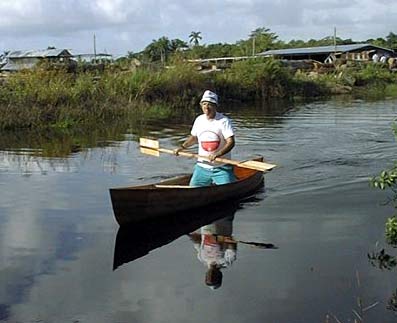
I was the first to paddle El Dorito
The personal demand for a similar boat for this writer came from
the (only) two shortcomings of my current paddleboat, the Bionic
Log. First, the Log, while light enough at 37 pounds, is a beast
to carry. Second, it is truly a dedicated solo boat and there’s
no way to haul a granddaughter or two around.
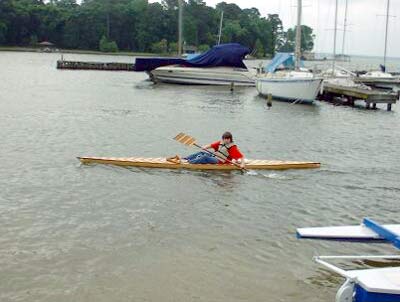
the Bionic Log
Locally, there aren’t any race categories for 60 year old
paddlers, it is about time to quit trying to maintain the 2 hrs
20 min, more or less, in the annual 15 mile Buffalo Bayou Regatta
(formerly Reeking Regatta, I still miss the old politically non
correct name). So now as I get older, my boats get shorter, and
wider. There are undoubtedly some corollaries here, but I’ll
just console myself with the idea that the boat will be lighter
and have a little less wetted surface area.
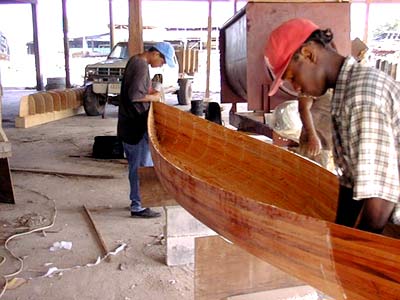
El Dorito under construction
On to specifics, El Dorito fit the bill pretty well but would
have looked and worked a little better with just a little less
depth. While we’re at it, let’s make the overall length
11’-8” instead of 12’ so we can use 12’
long strips and avoid a little bit of waste. As long as we’re
going to run the shapes through the computer again, let’s
change the station spacing to 9” instead of 10” so
we’ll be able to work a little easier with harder woods
plus the bulkhead location come out a bit more elegantly. We are
a ways from the part of the world where all small boats are called
dories so maybe a new name is in order. Easy to carry, easy to
paddle, easy would work, but the predecessor to the Bionic Log,
a 16’ 21# decked canoe was called Easy Does It, so Easy
B it will be.
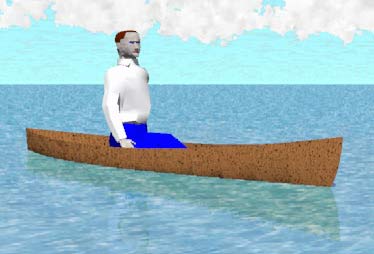
Easy B
The boat’s shape is derived mathematically with parabolic
curves for plan and profile with superelliptical cross sections,
which guarantees a perfectly fair shape capable of being manipulated
over a wide range. So our boat is 11’-8” L.O.A. 28”
maximum beam, a bit asymmetric, the midsection 8” back from
the midpoint. The sheer forward is fairly pronounced both for
appearance and to make stripping easier at the chin of the bow.
Just a little rocker, don’t need a lot of maneuverability
in such a short boat and less rocker also keeps the prismatic
coefficient up a bit, also a good thing in a short boat. Since
an absolutely straight keel line offends my sensibilities somehow
an inch or so will do. At the 4” waterline, our little boat
will displace 4 plus cubic feet of fresh water or 255 pounds with
a prismatic coefficient of 0.56 dragging 18.5 plus square feet
of wetted surface through the water. It will take about 82 pounds
to sink the boat an inch lower in the water, which should be about
as much as you’d ever want to load the boat. Take 80 pounds
out of the 255 leaves 175 pounds and you’ll be able to float
in 3” of water.
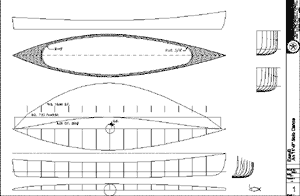
Click image above to enlarge
Take all this stuff with a small grain of salt, freshwater or
not. In the real world of wind, waves, current and all sorts of
macrocosmic chaos I don’t begin to understand, A boat is
a living dynamic thing, constantly changing and adapting to the
conditions of the moment. We should all do so well.
One last aside on numbers. The following nondimensional coefficient
comes from John Winters writings, read anything of his you come
across, he understands boats at a very fundamental level. The
wetted surface to volume ratio (S/V ^.67) for the Easy B is 7.21,
the lowest of any paddleboat I’ve done. For some comparisons,
Bionic Log, 8.64
Miss Lavi 8.28
Julie and Colin’s Safari Double 8.95
Ruta Maya
Racer (under construction) 7.85
6 man Safari boat 10.04
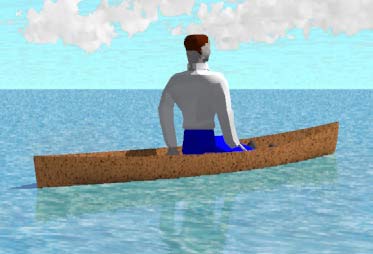
Construction will be pretty much conventional wood stripper,
¼” nominal wood strips with a layer of glass/epoxy
both sides, 5-oz in this case. Actually 3/16” thick strips
would work fine for a boat this size, but I’ve got a lot
of ¼” thick strips already on hand and have neither
the equipment nor inclination to take 1/32” off each side.
Going to 3/16” thick strips would save some weight though.
There is (are?) about 33 square feet of hull surface in EasyB
which corresponds to .6875 cubic feet of ¼” strips
or .516 cubic feet of 3/16” strips. At 22 pounds per cubic
foot that’s 15# versus 11.4#. Rather than trying to save
3 ½ pounds on this boat, I’ll wait and build a really
light boat (15#) on same form using 9mm PVC foam, kevlar and s-glass.
So 15# hull wood, 5# epoxy/glass and say 5# bulkheads, deck and
gunnels and I’m carrying a 25# boat. This I can do.
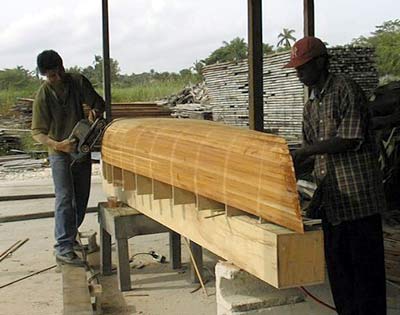
El Dorito again
Back to construction. Though conventional scantlings and lay-up,
Easy B will be built without using staples, using rubber bands
instead to hold the strips against forms cut from ¼”
pegboard. There was reason in having 9” station spacing,
easy to do since the shapes are derived mathematically. Bulkheads
will be laid up from scrap strips with glass/epoxy both sides.
Decks will be foam sandwich similar to the Bionic Log, which will
allow me to indulge my minor obsession with book matching. Back
when I was ripping my own strips, It was simple to rubber band
strips together in pairs making it easy to book match everything.
Now I’m content to just book match the decks with strips
resawn to 1/16” veneers laid over a foam base. Gunnels will
be spaced with spacers cut from 1” popular dowels to contrast
with the mahogany gunnels. The extra width using this format will
allow us to not require any thwarts in the boat plus have a multitude
of places to tie or fasten stuff and anchor footrest, leeboards
or whatever.
I’ll save what thoughts I’ve got on seats, paddles,
alternate propulsion and the like until later, the shape is done,
and that’s the thing for now. The accompanying movie shows
it well and at the risk of great hubris, I think it is just exquisite.
The pictures with mannequin give an excellent sense of scale;
it really is a small boat. The scale figure is reasonably accurate
5’10” tall, a little less than 200# but broader of
shoulder and narrower of waist than this writer, and he’s
got a lot more hair. He is also a little straight backed and is
sitting an inch or two higher than most of us would.
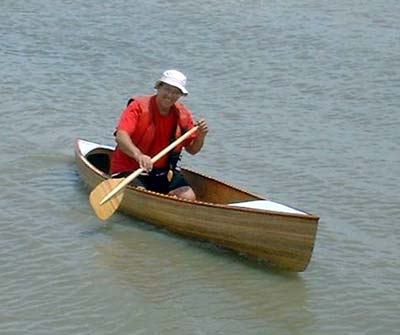
EasyB
Skip Johnson

|

